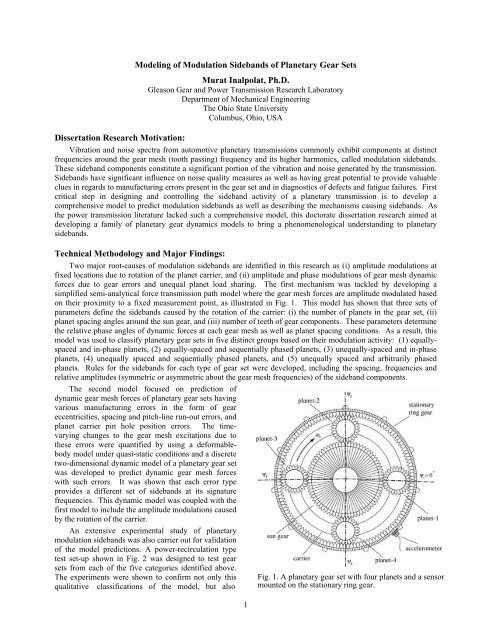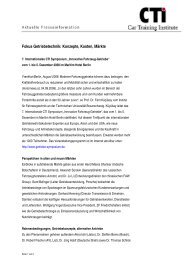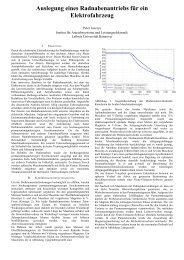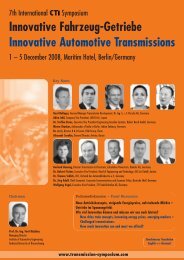Modeling of Modulation Sidebands of Planetary Gear Sets Murat ...
Modeling of Modulation Sidebands of Planetary Gear Sets Murat ...
Modeling of Modulation Sidebands of Planetary Gear Sets Murat ...
You also want an ePaper? Increase the reach of your titles
YUMPU automatically turns print PDFs into web optimized ePapers that Google loves.
<strong>Modeling</strong> <strong>of</strong> <strong>Modulation</strong> <strong>Sidebands</strong> <strong>of</strong> <strong>Planetary</strong> <strong>Gear</strong> <strong>Sets</strong><br />
<strong>Murat</strong> Inalpolat, Ph.D.<br />
Gleason <strong>Gear</strong> and Power Transmission Research Laboratory<br />
Department <strong>of</strong> Mechanical Engineering<br />
The Ohio State University<br />
Columbus, Ohio, USA<br />
Dissertation Research Motivation:<br />
Vibration and noise spectra from automotive planetary transmissions commonly exhibit components at distinct<br />
frequencies around the gear mesh (tooth passing) frequency and its higher harmonics, called modulation sidebands.<br />
These sideband components constitute a significant portion <strong>of</strong> the vibration and noise generated by the transmission.<br />
<strong>Sidebands</strong> have significant influence on noise quality measures as well as having great potential to provide valuable<br />
clues in regards to manufacturing errors present in the gear set and in diagnostics <strong>of</strong> defects and fatigue failures. First<br />
critical step in designing and controlling the sideband activity <strong>of</strong> a planetary transmission is to develop a<br />
comprehensive model to predict modulation sidebands as well as describing the mechanisms causing sidebands. As<br />
the power transmission literature lacked such a comprehensive model, this doctorate dissertation research aimed at<br />
developing a family <strong>of</strong> planetary gear dynamics models to bring a phenomenological understanding to planetary<br />
sidebands.<br />
Technical Methodology and Major Findings:<br />
Two major root-causes <strong>of</strong> modulation sidebands are identified in this research as (i) amplitude modulations at<br />
fixed locations due to rotation <strong>of</strong> the planet carrier, and (ii) amplitude and phase modulations <strong>of</strong> gear mesh dynamic<br />
forces due to gear errors and unequal planet load sharing. The first mechanism was tackled by developing a<br />
simplified semi-analytical force transmission path model where the gear mesh forces are amplitude modulated based<br />
on their proximity to a fixed measurement point, as illustrated in Fig. 1. This model has shown that three sets <strong>of</strong><br />
parameters define the sidebands caused by the rotation <strong>of</strong> the carrier: (i) the number <strong>of</strong> planets in the gear set, (ii)<br />
planet spacing angles around the sun gear, and (iii) number <strong>of</strong> teeth <strong>of</strong> gear components. These parameters determine<br />
the relative phase angles <strong>of</strong> dynamic forces at each gear mesh as well as planet spacing conditions. As a result, this<br />
model was used to classify planetary gear sets in five distinct groups based on their modulation activity: (1) equallyspaced<br />
and in-phase planets, (2) equally-spaced and sequentially phased planets, (3) unequally-spaced and in-phase<br />
planets, (4) unequally spaced and sequentially phased planets, and (5) unequally spaced and arbitrarily phased<br />
planets. Rules for the sidebands for each type <strong>of</strong> gear set were developed, including the spacing, frequencies and<br />
relative amplitudes (symmetric or asymmetric about the gear mesh frequencies) <strong>of</strong> the sideband components.<br />
The second model focused on prediction <strong>of</strong><br />
dynamic gear mesh forces <strong>of</strong> planetary gear sets having<br />
various manufacturing errors in the form <strong>of</strong> gear<br />
eccentricities, spacing and pitch-line run-out errors, and<br />
planet carrier pin hole position errors. The timevarying<br />
changes to the gear mesh excitations due to<br />
these errors were quantified by using a deformablebody<br />
model under quasi-static conditions and a discrete<br />
two-dimensional dynamic model <strong>of</strong> a planetary gear set<br />
was developed to predict dynamic gear mesh forces<br />
with such errors. It was shown that each error type<br />
provides a different set <strong>of</strong> sidebands at its signature<br />
frequencies. This dynamic model was coupled with the<br />
first model to include the amplitude modulations caused<br />
by the rotation <strong>of</strong> the carrier.<br />
An extensive experimental study <strong>of</strong> planetary<br />
modulation sidebands was also carrier out for validation<br />
<strong>of</strong> the model predictions. A power-recirculation type<br />
test set-up shown in Fig. 2 was designed to test gear<br />
sets from each <strong>of</strong> the five categories identified above.<br />
The experiments were shown to confirm not only this<br />
qualitative classifications <strong>of</strong> the model, but also<br />
1<br />
Fig. 1. A planetary gear set with four planets and a sensor<br />
mounted on the stationary ring gear.
demonstrated to match the predicted spectra quantitatively as illustrated in measured and predicted acceleration<br />
spectra displayed in Fig. 3.<br />
Major Contributions to the State-<strong>of</strong>-the-Art:<br />
This study provides the first published comprehensive methodology for modeling sidebands <strong>of</strong> planetary gear<br />
sets, fully describing the two major mechanisms <strong>of</strong> sidebands. The model allows a complete classification <strong>of</strong><br />
planetary gear sets for their expected sideband behavior based on their basic design parameters. It also provides the<br />
foundation for future diagnostics, prognostics and sound quality studies on planetary transmissions. The<br />
experimental database formed in this study can be viewed as one <strong>of</strong> the most extensive databases focusing on<br />
planetary gear sidebands, which will be instrumental in validating and guiding future modeling efforts.<br />
Journal Publications Based on the Dissertation Research<br />
• M. Inalpolat, A. Kahraman, A theoretical and experimental investigation <strong>of</strong> modulation sidebands <strong>of</strong> planetary<br />
gear sets, Journal <strong>of</strong> Sound and Vibration, 323, 677-696, 2009.<br />
• M. Inalpolat, A. Kahraman, A dynamic model to predict modulation sidebands <strong>of</strong> a planetary gear set having<br />
manufacturing errors, Journal <strong>of</strong> Sound and Vibration, doi:10.1016/j.jsv.2009.09.022, 2009.<br />
• M.Inalpolat, A. Kahraman, Dynamic modeling <strong>of</strong> planetary gears <strong>of</strong> automatic transmissions, IMechE, Part K:<br />
Journal <strong>of</strong> Multi-body Dynamics, 222(3), 229-242, 2008.<br />
(a)<br />
rotary<br />
union<br />
reaction ring<br />
gear loading<br />
flange<br />
reaction<br />
ring gear<br />
carriers<br />
test ring<br />
gear<br />
test sun<br />
gear<br />
(b)<br />
input shaft<br />
connecting<br />
sun gears<br />
mounting<br />
flange<br />
housing<br />
h ollow shaft<br />
connectin<br />
carriers<br />
test ring<br />
adaptor<br />
(c)<br />
(d)<br />
Fig. 2 (a) Cross-section <strong>of</strong> the back-to-back planetary test fixtures, (b) the test set-up on a transmission dynamometer, (c)<br />
3, 4 and 5 planet carriers used in this study, and (d) accelerometers mounted radially on the outside surface <strong>of</strong> the test ring<br />
gear.<br />
2
(a)<br />
(b)<br />
Fig. 3. (a) Measured and (b) predicted acceleration spectra from a 4-planet planetary gear set.<br />
3












